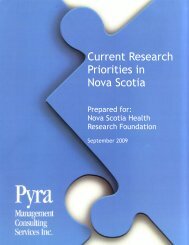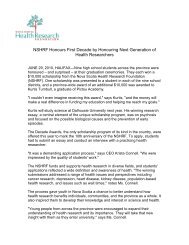Major Health Issues in Nova Scotia: An Environmental Scan
Major Health Issues in Nova Scotia: An Environmental Scan
Major Health Issues in Nova Scotia: An Environmental Scan
You also want an ePaper? Increase the reach of your titles
YUMPU automatically turns print PDFs into web optimized ePapers that Google loves.
# Reference Brief Notes<br />
kidney disease that can result from electronically prompt<strong>in</strong>g cl<strong>in</strong>icians<br />
with evidence-based treatment advice.<br />
21. Lewanczuk,R. Hypertension as a chronic<br />
disease: What can be done at a regional level?<br />
Can.J.Cardiol.; 2008; 24(6):483-4.<br />
22. Lewis,A. How to measure the outcomes of<br />
chronic disease management.<br />
Popul.<strong>Health</strong>.Manage); 2009; 12(1):47,54 (7<br />
ref).<br />
23. L<strong>in</strong>dau,ST, Laumann,EO, Lev<strong>in</strong>son,W, et al.<br />
Synthesis of scientific discipl<strong>in</strong>es <strong>in</strong> pursuit<br />
of health: The <strong>in</strong>teractive biopsychosocial<br />
model. Perspect.Biol.Med.; 2003; 46(3<br />
Suppl):S74-86.<br />
24. Lynch,M, Hernandez,M and Estes,C. PACE:<br />
Has it changed the chronic care paradigm?<br />
Soc.Work.Public.<strong>Health</strong>.; 2008; 23(4):3-24.<br />
25. Mc<strong>An</strong>drew,LM, Musumeci-Szabo,TJ,<br />
Mora,PA, et al. Us<strong>in</strong>g the common sense<br />
model to design <strong>in</strong>terventions for the<br />
prevention and management of chronic<br />
illness threats: From description to process.<br />
Br.J.<strong>Health</strong>.Psychol.; 2008; 13(Pt 2):195-204.<br />
26. McEvoy,P and Barnes,P. Us<strong>in</strong>g the chronic<br />
care model to tackle depression among older<br />
adults who have long-term physical<br />
conditions. J.Psychiatr.Ment.<strong>Health</strong> Nurs.;<br />
Historically, management of chronic diseases such as hypertension<br />
has tended to be reactive, with patients be<strong>in</strong>g passive recipients of<br />
care. In recent years, the chronic care model has been developed and<br />
implemented <strong>in</strong> many jurisdictions to ensure optimal, proactive care<br />
of people with chronic conditions. The model and its pr<strong>in</strong>ciples<br />
address the <strong>in</strong>frastructure and support that is necessary to enable this<br />
high-quality care. The role of the patient, primary care team, system<br />
and community are all addressed <strong>in</strong> this model. Experience suggests<br />
that application of chronic disease management pr<strong>in</strong>ciples to<br />
hypertension can result <strong>in</strong> significant benefits to all concerned.<br />
The fastest-grow<strong>in</strong>g methodology for disease management outcomes<br />
measurement is valid, transparent, easy to apply, and freely available<br />
<strong>in</strong> the public doma<strong>in</strong> and this article. It measures the actual goal of<br />
disease management, which is to reduce the rate of adverse events<br />
associated with the disease(s) be<strong>in</strong>g managed. Changes <strong>in</strong> this rate can<br />
be translated <strong>in</strong>to a return on <strong>in</strong>vestment us<strong>in</strong>g some explicit<br />
assumptions about comorbidities and episode costs. Outcomes<br />
measured <strong>in</strong> this way show that <strong>in</strong> the health plan community as a<br />
whole, disease management <strong>in</strong> the broadest sense is work<strong>in</strong>g, as<br />
measured by the relative stability <strong>in</strong> the rate of adverse medical events<br />
closely associated with common chronic disease dur<strong>in</strong>g this decade of<br />
<strong>in</strong>creas<strong>in</strong>g prevalence of most of the common chronic conditions.<br />
We present the Interactive Biopsychosocial Model (IBM). The IBM<br />
argues for a reorientation <strong>in</strong> biomedic<strong>in</strong>e where research, education,<br />
and cl<strong>in</strong>ical practice: (1) address health <strong>in</strong> addition to illness; (2) aim<br />
to decipher <strong>in</strong>terrelated biophysical, psychocognitive, and social<br />
processes <strong>in</strong> health and disease, rather than seek a s<strong>in</strong>gle root cause;<br />
and (3) take <strong>in</strong>to account the social networks of the <strong>in</strong>dividual to<br />
achieve, ma<strong>in</strong>ta<strong>in</strong>, and maximize health and well-be<strong>in</strong>g for <strong>in</strong>dividuals,<br />
their significant others, and society. The model provides a dynamic,<br />
dyadic, framework for build<strong>in</strong>g scientific hypotheses about the<br />
etiologies and consequences of health, well-be<strong>in</strong>g, and disease<br />
throughout the life course.<br />
The Program of All-<strong>in</strong>clusive Care for the Elderly (PACE) grew out<br />
of a small community organization <strong>in</strong> San Francisco and has been<br />
replicated by non-profit organizations <strong>in</strong> a number of other<br />
communities across the country. The authors review the successes of<br />
PACE as reported <strong>in</strong> the literature and discuss reasons for its limited<br />
growth as well as its significant <strong>in</strong>fluence on state and federal long<br />
term care policy.<br />
In this article, the author’s discuss how one might use the common<br />
sense model of self-regulation (CSM) for develop<strong>in</strong>g <strong>in</strong>terventions for<br />
improv<strong>in</strong>g chronic illness management. They describe two separate,<br />
ongo<strong>in</strong>g <strong>in</strong>terventions with patients with diabetes and asthma to<br />
demonstrate the adaptability of the CSM. They also discuss three<br />
additional factors that need to be addressed before plann<strong>in</strong>g and<br />
implement<strong>in</strong>g <strong>in</strong>terventions: (1) the use of top-down versus bottomup<br />
<strong>in</strong>tervention strategies; (2) health care <strong>in</strong>terventions <strong>in</strong>volv<strong>in</strong>g<br />
multidiscipl<strong>in</strong>ary teams; and (3) fidelity of implementation for tailored<br />
<strong>in</strong>terventions.<br />
Effective psychological and pharmacological treatments are available,<br />
but for depressed older adults with long-term physical conditions, the<br />
outcome of rout<strong>in</strong>e care is generally poor. This paper <strong>in</strong>troduces the<br />
chronic care model, a systemic approach to quality improvement and











